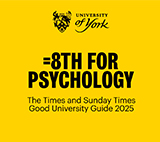
PhD Talks
Tuesday 30 April 2024, 4.00PM to 5.00pm
Speaker(s): Kira Noad, Bee Quinn, Kirralise Hansford
- Kira Noad - The importance of conceptual knowledge when becoming familiar with faces during naturalistic viewing
Although the ability to recognise familiar faces is a critical part of everyday life, the process by which a face becomes familiar is not fully understood. Previous work has focussed on perceptual experience. However, when we become familiar with people in the real world, conceptual knowledge also increases. Here, we used a natural viewing paradigm to investigate the role of conceptual knowledge when learning new faces. Participants viewed clips from a TV show that were manipulated by presenting events in the original order or a scrambled sequence. Although scrambling significantly decreased the conceptual understanding of the events, it had no effect on the perceptual exposure to the faces. Nevertheless, we found that subsequent face recognition of characters from the TV show was greater in participants from the original group. Participants also viewed a new movie from the TV show while neural activity was recorded using fMRI. Greater neural similarity was evident between participants in the original group within regions that are associated with the processing of semantic, episodic and affective information. Together, these findings suggest that conceptual information is important for learning new faces, and that the neural correlates are evident in regions within and beyond the visual brain. - Bee Quinn - "A visual field bias for familiar face recognition"
When we observe faces during natural viewing, the left and right halves of faces typically project to visual cortex in the contralateral hemisphere. In a similar way, the upper and lower halves of the face typically project to ventral and dorsal regions of visual cortex. However, it is unclear if our experience of faces in typical locations of the visual field (e.g., right half – left hemisphere, or upper half - ventral cortex) influences face recognition. In this study, participants (n = 32) viewed left, right, upper, and lower face halves that were presented in either the typical or atypical visual field location. Participants made familiarity judgements on familiar or unfamiliar faces. The results showed improved reaction time and accuracy for face halves that were presented in their typical visual fields. However, when responses to familiar and unfamiliar faces were separated, this effect was clearly driven by familiar faces, with little evidence of any visual field effects for unfamiliar faces. Our findings imply that our experience of familiar faces in their typical locations facilitates recognition and suggests that matching images of familiar faces to their representations in memory shows some level of image dependency. " - Kirralise Hansford - "Somatosensory response changes during illusory finger stretching: A Registered Report"
Resizing illusions, delivered using augmented reality, resize a body part through either stretching or shrinking manipulations. These resizing illusions have been investigated in visuotactile, visual-only, and visuo-auditory presentations. However, the neural underpinnings of these resizing illusions remain undefined. This registered report study sought to understand the neural mechanisms behind these illusions in healthy participants (n = 46), by using somatosensory steady state evoked potentials in addition to subjective self-report questionnaires, to enhance knowledge of what drives the subjective embodiment during resizing illusions. Resizing Illusions have been shown to provide analgesic effects for individuals with chronic pain conditions, therefore, this study also aimed to provide an empirical basis for later investigations in chronic pain samples undergoing resizing illusions. Results demonstrated that subjective measures found significant differences between non-illusion and multisensory illusion conditions regarding experience of the illusion, and whilst the omnibus test statistics for EEG data measuring somatosensory responses to 26Hz stimulation to the resized digit showed a significant difference across resizing conditions, with illusory conditions having lower median amplitude values compared to non-illusion conditions, no conditions showed significant differences after post-hoc comparisons. These findings demonstrate a potential dichotomy between subjective and neural responses to resizing illusions and provide a basis for investigations of comparable subjective and steady state illusion responses in a chronic pain population.
Location: PS/B/020
